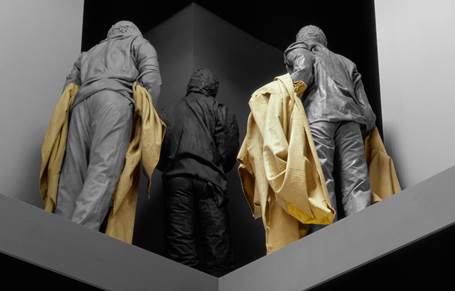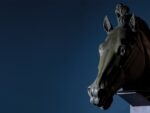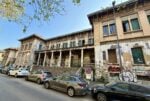Juan Muñoz – Double Bind & Around

Il progetto espositivo, a cura di Vicente Todolí, reinterpreta gli spazi di HangarBicocca e propone 15 fondamentali opere dell’artista che amava definirsi uno “storyteller”. Dopo 14 anni, viene presentata al pubblico Double Bind la sua più importante e colossale opera realizzata nel 2001 per la Tate Modern di Londra, poco prima della sua scomparsa.
Comunicato stampa
HangarBicocca, lo spazio per l’arte contemporanea sostenuto da Pirelli, presenta Double Bind & Around la prima mostra personale in Italia dedicata a Juan Muñoz, a cura di Vicente Todolí.
L’intero progetto espositivo, che si espande nei 5.300 metri quadrati delle “Navate” di HangarBicocca, propone 15 opere (con oltre 100 figure scultoree) di uno degli artisti più significativi del panorama contemporaneo e comprende i suoi lavori più rilevanti, tra cui The Wasteland (1986), Waste Land (1986), Ventriloquist Looking at a Double Interior (1988-2000), Conversation Piece, Dublin (1994), The Nature of Visual Illusion (1994-1997) e Many Times (1999).
Centrale nel percorso della mostra, si configura la sua opera più imponente, Double Bind, installazione realizzata per la Turbine Hall della Tate Modern di Londra nel 2001 e da allora mai più esposta.
Definito dalla critica uno degli artisti più complessi e singolari del nostro tempo, Juan Muñoz era solito parlare di sé come di un “storyteller”.
Tra gli artisti più significativi a emergere nel periodo che segue la dittatura franchista in Spagna, è stato un interprete visionario e artefice di un’arte che pone al centro la figura umana. Capace di creare contesti stranianti, mondi fittizi abitati da bizzarri personaggi come acrobati, ventriloqui, ballerine e nani solitari, le sue opere danno forma a possibili narrazioni.
“La scultura avvolge lo spazio che occupa, restringendolo dall’estremità al centro in tutta la sua estensione, come un foglio che volteggia nell’aria prima di posarsi sul tavolo o sul suolo” (da Juan Muñoz, “Writings/Escritos”, a cura di Adrian Searle, ediciones de la Central, Madrid 2009).
Affascinato dalla statuaria romana e dall’architettura barocca del XVII secolo, (trascorre un anno a Roma nel 1991), Juan Muñoz ha indagato il rapporto tra la figura e il contesto espositivo. Egli ha esplorato nuove possibilità di distorsione dello spazio, utilizzando prospettive ardite e cambiamenti di scala, non solo per coinvolgere le capacità sensoriali e percettive dello spettatore, ma anche e soprattutto per creare una tensione psicologica nell’individuo che fruisce delle opere.
Il suo interesse per l'arte dell’illusione lo ha portato a trasmettere un forte senso di ambiguità ed enigmaticità, dove i confini tra realtà e finzione si assottigliano, accrescendo un articolato gioco di contraddizioni e paradossi.
In una riflessione che attraversa il linguaggio della scultura, dell'architettura, del disegno, dell'installazione, del suono e della scrittura, e attingendo da riferimenti legati al cinema, alla fotografia e anche alla magia, l'artista ha aperto il campo d’indagine all’emozione e ad una maggiore interazione psicologica con lo spettatore.
L'installazione Double Bind rappresenta la più significativa creazione dell'artista, morto nel 2001 all'età di 48 anni, pochi mesi dopo la sua realizzazione. Concepita ed esposta negli spazi della Turbine Hall all'interno del progetto Unilever Series presso la Tate Modern (Londra, 2001), non è mai più stata ricostruita.
Double Bind viene ripresentata riadattandola completamente su una superficie di 1.500 metri quadrati e intervenendo sui volumi verticali dello spazio ex industriale di HangarBicocca. Formata da una serie di scenari oscuri e da elementi architettonici che giocano sul contrasto tra visibile e invisibile, tra realtà e illusione, essa si compone strutturalmente di tre piani e due ascensori in continuo movimento. Dal piano superiore, il visitatore fruisce della visione di una superficie con forme geometriche che contiene buchi e condotti reali e illusori. Al livello intermedio, invece, appaiono figure scultoree singole o in gruppo bloccate nei loro atteggiamenti in una dimensione temporale e spaziale indefinita. Muñoz crea un insieme architettonico asettico attraverso elementi strutturali, come griglie e finestre sbarrate. E’ l’artista stesso a definire l’esperienza dello spettatore come se si trovasse in una città anzichè in un museo (da Double Bind at Tate Modern, Tate Publishing, Londra 2001).
La mostra Double Bind & Around, nel suo complesso, modifica gli spazi di HangarBicocca, e raggruppa alcune delle opere più importanti di Juan Muñoz, tra cui The Wasteland (1986), formata da un pavimento di pattern geometrici colorati e dal manichino di un ventriloquo poggiato su una mensola, Waste Land (1986), dove il ventriloquo è collocato su un muro di fronte a un pavimento optical, e Many Times (1999), formata da una “folla” di figure dal volto orientale disposte nello spazio le cui espressioni raffigurano dei ghigni taglienti.
Sono presenti inoltre diversi Conversation Piece, gruppi scultorei sviluppati dai primi anni Novanta. Essi sono composti da figure anonime collocate in spazi altrettanto generici. I personaggi, le cui forme ricordano quelle umane, hanno delle strutture sferiche al posto delle gambe. Ciascuna figura occupa lo spazio, assumendo pose diverse, mentre conversa, osserva o ascolta fatti ed eventi che rimangono taciuti e incomprensibili allo spettatore. I personaggi di Hanging Figures (1997) sono invece raffigurati in pose inverosimili mentre fluttuano nell’aria come acrobati. Quest’opera è ispirata al capolavoro di Edgar Degas Mademoiselle La La al Circo Fernando del 1879 in cui l'artista rappresenta un’acrobata con un ardito scorcio dal basso.
Juan Muñoz (1953 – 2001)
Nasce a Madrid, secondo di sette figli. Cresce nell’era franchista e a metà degli anni Settanta si trasferisce in Inghilterra dove studia al Central School of Art and Design e al Croydon College of Design and Technology,città in cui conosce la sua futura moglie, la scultrice Cristina Iglesias. Nel suo percorso professionale ha modo di incontrare molti artisti tra cui Richard Serra e Mario Merz. Ma nonostante abbia conosciuto il Minimalismo e l’Arte Povera, egli imbocca un percorso diametralmente opposto che lo porta ad affermare un’arte del tutto peculiare nella scultura contemporanea.
Conosciuto soprattutto per le sue sculture in papier maché, resina e bronzo, Juan Muñoz si è interessato anche alle arti sonore, creando composizioni per la radio e audio pieces. Egli ha inoltre sviluppato un'intensa produzione testuale – diversi suoi scritti sono stati pubblicati in cataloghi, quotidiani e riviste, tra cui Domus e Figura – e ha collaborato con musicisti e attori per la creazione di performance sonore, alcune delle quali saranno presentate in HangarBicocca. Gli sono state dedicate retrospettive in importanti istituzioni, fra cui: Hirshhorn Museum & Sculpture Garden, Washington DC (2001), Museum of Contemporary Art, Los Angeles (2002), The Art Institute of Chicago (2002), Contemporary Arts Museum, Houston (2003), Musée de Grenoble, Grenoble (2007), Tate Modern, Londra (2008) e Museo Nacional Centro de Arte Reina Sofía, Madrid (2009).
Il programma espositivo di HangarBicocca
L’esposizione Double Bind & Around si colloca all’interno del programma di mostre firmato dal direttore artistico Vicente Todolí insieme al curatore Andrea Lissoni. Il calendario 2015 di HangarBicocca proseguirà con le mostre di Damián Ortega (11 giugno – 8 novembre 2015) e Philippe Parreno (ottobre 2015 – febbraio 2016).
HangarBicocca e Pirelli
HangarBicocca, lo spazio per l’arte contemporanea di Pirelli, è il naturale proseguimento di una lunga tradizione di attenzione verso la cultura, la ricerca e l’innovazione che accompagna l’azienda fin dalla sua fondazione avvenuta oltre 140 anni fa. Grazie all’impegno di Pirelli, HangarBicocca rende accessibile al pubblico una programmazione di alto livello e una serie di attività per ragazzi e famiglie, ed è diventato ormai un punto di riferimento per Milano e per il pubblico internazionale.
Curated by Vicente Todolí, the show reshapes the HangarBicocca exhibition space, with 15 foundational works by the artist, who saw himself as a "storyteller".
Double Bind, his most important and monumental work, originally made for Tate Modern in London in 2001, shortly before his death, is being shown again 14 years later.
9 April – 23 August 2015
Press Conference 7 April 2015, 11 a.m.
Opening 8 April 2015, 7 p.m.
HangarBicocca, the contemporary art space promoted by Pirelli, presents Double Bind & Around, the first solo exhibition in Italy devoted to Juan Muñoz and curated by Vicente Todolí.
The exhibition covers 5,300 square meters of the nave and aisles of HangarBicocca and, includes 15 works (with over 100 sculptures) by one of the most important artists of our time. It comprises his most significant works, including The Wasteland (1986), Waste Land (1986), Ventriloquist Looking at a Double Interior (1988-2000), Conversation Piece, Dublin (1994), The Nature of Visual Illusion (1994-1997) and Many Times (1999).
The exhibition centres on his most significant work, Double Bind, an installation made in 2001 for the Turbine Hall at Tate Modern in London. It is now being shown again for the first time since then.
Defined as one of the most complex and unique contemporary artists, Juan Muñoz saw himself as a "storyteller".
One of the most important artists to emerge in Spain after the Franco dictatorship, he was a visionary who placed the human figure at the centre of his art. His alienating settings and fictitious worlds inhabited by bizarre characters such as acrobats, ventriloquists, ballerinas and solitary dwarfs, give rise to countless possible narratives.
"Sculpture twists the space it occupies, squeezing it from edges to middle, in all its extension, like a sheet that flaps in the air before being laid on the table-floor" (from Juan Muñoz, "Writings/Escritos", edited by Adrian Searle, Ediciones de la Central, Madrid 2009).
Fascinated by Roman statues and by seventeenth-century Baroque architecture (he spent a year in Rome in 1991), Juan Muñoz investigated the relationship between the human figure and the exhibition setting. He explored new ways of distorting space, using daring perspectives and variations in scale, not just to engage the viewer's at the level of perception and the senses but also, and especially, to create a psychological tension within the individual who interacts with the work.
His interest in the art of illusion led him to convey a powerful sense of ambiguity and enigma, in which the boundaries between reality and fiction are blurred, creating an increasingly complex play of contradictions and paradoxes.
The artist thus broadened his field of investigation to the emotions and to a greater psychological interaction with the viewer, and he did so by working with the languages of sculpture, architecture, drawing, installation, sound and writing, using references to the cinema and photography, as well as magic.
The Double Bind installation is the most significant work created by the artist, who died in 2001 aged 48, just a few months after presenting it to the public. Designed for and shown in the Turbine Hall as part of the Unilever Series at Tate Modern (London, 2001), it has never been reconstructed since.
Double Bind is now being represented - adapted to fit an area of 1500 square metres - and exploiting the vertical volumes of the former industrial space of HangarBicocca. Consisting of a series of dark scenarios with architectural elements that play on the contrast between the visible and the invisible, reality and illusion, in structural terms it consists of three floors and two constantly moving elevators. From the top floor, the visitor can look out over a surface of geometric forms, which contains holes or shafts that may be real or illusory. On the intermediate level, on the other hand, figures appear, alone or in groups, locked into poses that belong to an indefinite space-time dimension. Muñoz creates an aseptic architectural world, using structural elements such as barred windows and gratings. It is the artist himself who defines the viewers' experience, as though they were in a city rather than a museum (from Double Bind at Tate Modern, Tate Publishing, London 2001).
The Double Bind & Around exhibition as a whole modifies the HangarBicocca spaces, and brings together some of Juan Muñoz's most important works, including The Wasteland (1986), with a floor made of coloured geometric patterns and a ventriloquist's dummy sitting on a shelf, Waste Land (1986), in which the ventriloquist is placed on a wall above an optical floor, and Many Times (1999), which consists of a "crowd" of figures with oriental features and caustic grins arranged around the space.
There are also a number of Conversation Pieces dating from the early 1990s. These consist of anonymous figures arranged in equally generic spaces. The characters, whose shape makes them look vaguely human, have spherical structures in place of legs. Each figure occupies the space in a different pose, conversing, observing or listening to facts and events that are unspoken, and thus incomprehensible to the viewer. The characters in Hanging Figures (1997), on the other hand, are shown in implausible poses as they flutter like acrobats in the air. This work is inspired by Miss La La at the Cirque Fernando, an 1879 masterpiece by Edgar Degas, which shows an acrobat in a daring perspective from below.
Juan Muñoz (1953 - 2001)
Juan Muñoz was born in Madrid, the second of seven children. He grew up under the Franco regime and in the mid-1970s moved to England, where he studied at the Central School of Art and Design and at the Croydon college of Design and Technology in London, the city where he met his future wife, the artist Cristina Iglesias. During his career he encountered many artists, including Richard Serra and Mario Merz. However, even though he knew of Minimalism and Arte Povera, he opted to go in a diametrically opposite direction, which led him to assert a form of art like no other in contemporary sculpture.
Known mainly for his sculptures in papier mâché, resin and bronze, Juan Muñoz often took an interest also in the sound art, creating compositions for the radio and audio pieces. He also wrote intensely and some of his writings have been published in catalogues, newspapers and magazines - including Domus and Figura - and he worked with musicians and actors on sound performances, some of which will be presented at HangarBicocca.
Retrospective exhibitions have been devoted to his work by leading institutions, including Hirshhorn Museum & Sculpture Garden, Washington DC (2001), Museum of Contemporary Art, Los Angeles (2002), The Art Institute of Chicago (2002), Contemporary Arts Museum, Houston (2003), Musée de Grenoble, Grenoble (2007), Tate Modern, Londra (2008) and Museo Nacional Centro de Arte Reina Sofía, Madrid (2009).
The HangarBicocca exhibition programme
Double Bind & Around is part of the programme of exhibitions curated by artistic director Vicente Todolí together with curator Andrea Lissoni. The 2015 calendar of HangarBicocca will continue with exhibitions by Damián Ortega (11 June – 8 November 2015) and Philippe Parreno (October 2015 – February2016).
HangarBicocca and Pirelli
HangarBicocca, the Pirelli contemporary art space, is the natural continuation of the long commitment to culture, research and innovation that has been a key feature of the company ever since it was founded over 140 years ago. Thanks to the support of Pirelli, HangarBicocca offers the public a prestigious programme and a whole series of activities for children and families, making it a centre of attraction for Milan and for an international public.



